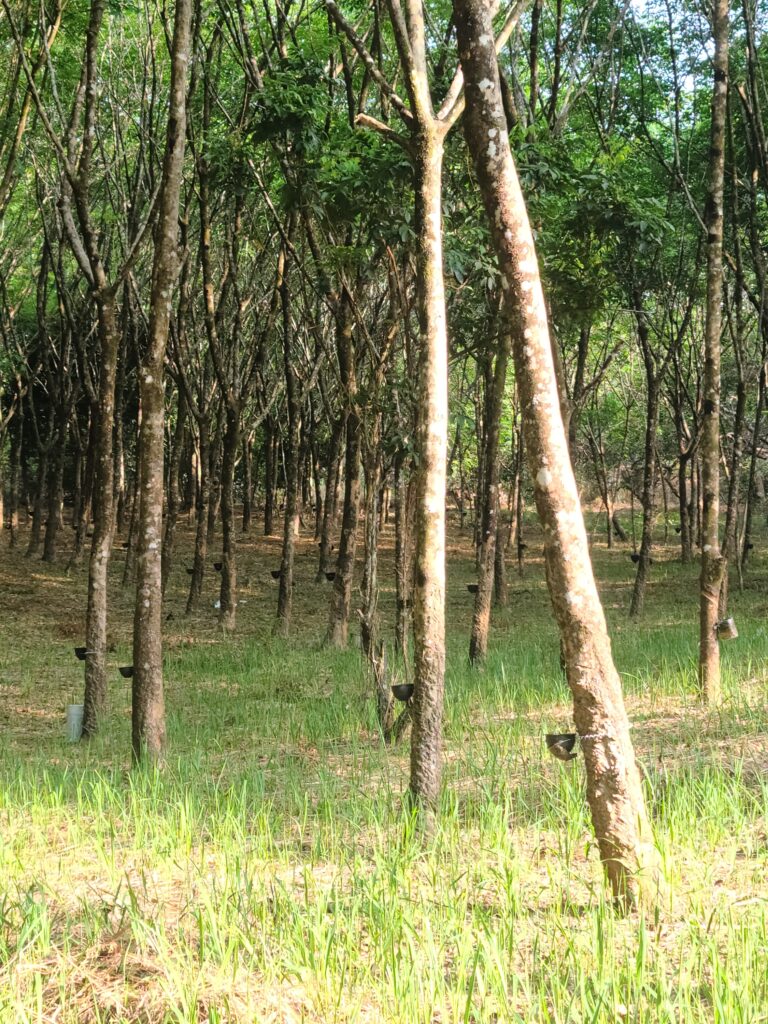

Thailand is a beautiful country with many different types of agriculture and livestock production. Three of the largest crops I saw while traveling the country were rubber production, palm oil trees and coconuts. In this article we will discuss the production of natural rubber(latex) from rubber tree plantations. In today’s bustling world of synthetic fabrics and materials, it is hard to imagine that there still exists a natural rubber production. Far away from the bustle of modern life in developed countries, in northwest Thailand there are large plantations of rubber trees. These trees are still producing natural rubber one slow drip at a time. The photos and short video show how the bark is cut away causing the milky white sap to ooze out of the tree and slowly drain along the cut bark into a small pipe that drips into a small collection vessel, slightly larger than two hands cupped together. The slow pace of the flowing sap and the peaceful quiet under the shade trees hid the amount of work it must take the farmers to tend the plantations of tall (40-60 ft) trees. As the photos show, the trees are tall with nearly smooth trunks up to the top set of leaves. This created an undisturbed area at the base of the trees which when left unsprayed (as all were I observed) allows for an understory of plants to provide habitat for wildlife under the cool shade of the trees. Stepping from under the shade the sun was direct and hot. Under the acres and acres of tall rubber trees it was much cooler and pleasant. In a way, imitating the surrounding natural jungle. As far as agriculture conditions go, this understory seemed like a nice place to work. I would have loved the opportunity to walk further into the plantations then I did.
It struck me how well this crop production was suited for organic certification. It was not a mechanized production, nor was the understory sprayed with herbicides. The rubber sap was harvested by hand, each tree fitted with a collection cup and drainage straw. It must take a lot of trees to produce enough natural rubber for processing. The key would be to identify products that would be able to market the “Organic” status of the natural rubber. Products exported to developed nations where consumer sensitivities would see the value in, and pay more, for an organic natural rubber. As production is limited and the goal of a better price for the farmers, the emphasis should be on a finished product that is small in size but has a higher value. Products that are used next to the skin or products that are used for food. Organic spatulas for the kitchen, organic latex gloves worn against the skin, other uses made with organic natural latex would have an extra marketing appeal.
With little or no herbicide or pesticide use, with the understory shaded and providing habitat for wildlife, natural rubber production was seen as a great crop for the remote islands and country sides of the growing regions. The key to helping the farmers and towns they support would be to get the industry certified as organic and to market that now organic natural rubber to products that would benefit from consumer preference for organics. Anything we could do to bolster the farm price for this amazing product would be a big help to everyone involved.
Chris Van Hook is an agricultural attorney working primarily in the USDA NOP regulations worldwide. He is based out of Northern California, has been in agriculture his entire life, attending law school in his mid 40’s. Email Chris with any comments or questions at: chris@cvanhooklaw.com